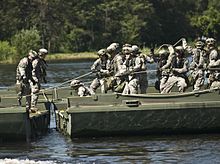- Military engineering
-
For soldiers who perform construction and demolition tasks in battle, see Combat engineer. For engineering research and development conducted for the military, see Military technology.Relief map of the Citadel of Lille, designed in 1668 by Vauban, the foremost military engineer of his age.
 Lists
ListsPortal In military science, engineering refers to the practice of designing, building, maintaining and dismantling military works, including offensive, defensive and logistical structures, to shape the physical operating environment in war.[1] It most often deals with fortifications and earthworks, the laying and clearing minefields, and the construction and destruction of bridges.
Military engineering is an important academic subject taught in military academies. The construction and demolition tasks related to military engineering are usually performed by soldiers trained as sappers or pioneers.[2] In modern armies, soldiers trained to perform such tasks while well forward in battle and under fire are often called combat engineers.
In some countries, soldiers may also perform non-military construction tasks in peacetime such as flood control and river navigation works, but such activities do not fall within the scope of military engineering.
Contents
Origins
The word engineer was initially used in the context of warfare, dating back to 1325 when engine’er (literally, one who operates an engine) referred to "a constructor of military engines".[3] In this context, "engine" referred to a military machine, i. e., a mechanical contraption used in war (for example, a catapult).
As the design of civilian structures such as bridges and buildings matured as a technical discipline, the term civil engineering[4] entered the lexicon as a way to distinguish between those specializing in the construction of such non-military projects and those involved in the older discipline. As the prevalence of civil engineering outstripped engineering in a military context and the number of disciplines expanded, the original military meaning of the word “engineering” is now largely obsolete. In its place, the term "military engineering" has come to be used.
History
Perhaps the first civilization to have a dedicated force of military engineering specialists were the Romans, whose army contained a dedicated corps of military engineers known as Roman military engineering was pre-eminent amongst its contemporaries, and the scale of certain military engineering feats, such as the construction of a double-wall of fortifications 30 miles (48 km) long in total (both walls combined total) in just six weeks to completely encircle the besieged city of Alesia in 52 B.C. Such military engineering feats would have been completely new, and probably bewildering and demoralizing, to the Gallic defenders. The best known of these Roman army engineers due to his writings surviving is Vitruvius.
In ancient times, military engineers were responsible for siege warfare and building field fortifications, temporary camps and roads. The most notable engineers of ancient times were the Romans and Chinese, who constructed huge siege-machines (catapults, battering rams and siege towers) and were responsible for constructing fortified wooden camps and paved roads for their legions. Many of these Roman roads are still in use today.
In the Middle Ages military engineering focused on siege warfare. They planned castles and fortresses. When laying siege, they planned and oversaw efforts to penetrate castle defences. When castles served a military purpose, one of the tasks of the sappers was to weaken the bases of walls to enable them to be breached before means of thwarting these activities were devised. Broadly speaking, sappers were experts at demolishing or otherwise overcoming or bypassing fortification systems.
With the 14th century development of gunpowder, new siege engines in the form of cannons appeared. Initially military engineers were responsible for maintaining and operating these new weapons just as had been the case with previous siege engines. In England, the challenge of managing the new technology resulted in the creation of the Office of Ordnance around 1370 in order to administer the cannons, armaments and castles of the kingdom. Both military engineers and artillery formed the body of this organization and served together until the office's predecessor, the Board of Ordnance was disbanded in 1855.[5]
In comparison to older weapons, the cannon was significantly more effective against traditional medieval fortifications. Military engineering significantly revised the way fortifications were built in order to be better protected from enemy direct and plunging shot. The new fortifications were also intended to increase the ability of defenders to bring fire onto attacking enemies. Fort construction proliferated in 16th century Europe based on the trace italienne design.[6]
By the 18th century, regiments of foot (infantry) in the British, French, Prussian and other armies included pioneer detachments. In peacetime these specialists constituted the regimental tradesmen, constructing and repairing buildings, transport wagons, etc. On active service they moved at the head of marching columns with axes, shovels and pickaxes clearing obstacles or building bridges to open the way for the bulk of the regiment to move through difficult terrain. The modern Royal Welch Fusiliers and French Foreign Legion still maintain pioneer sections who march at the front of ceremonial parades, carrying chromium plated tools intended for show only. Other historic distinctions include long work aprons and the right to wear beards.
The dawn of the internal combustion engine marked the beginning of a very significant change for military engineering. With the arrival of the automobile at the end of the 19th century and heavier than air flight at the start of the 20th century, military engineers would absorbe a major new role to support the movement and deployment of these systems in war. Military engineers gained vast knowledge and experience in explosives. They are tasked with planting bombs, landmines and dynamite.
At the end of World War I, the standoff in the Western Front caused the Imperial German Army to gather experienced and particularly skilled soldiers to form "Assault Teams" which would break through the Allied trenches. With enhanced training and special weapons (such as flamethrowers), these squads obtained some success, but too late to change the outcome of the war. In early WWII, however, the Wehrmacht "Pioniere" battalions proved their efficiency in both attack and defense, somewhat inspiring other armies to develop their own combat engineers battalions. Notably, the attack on Fort Eben-Emael in Belgium was conducted by Luftwaffe glider-deployed combat engineers.
The need to defeat the German defensive positions of the "Atlantic wall" as part of the amphibious landings in Normandy in 1944 led to the development of specialist combat engineer vehicles. These, collectively known as Hobart's Funnies, included a specific vehicle to carry combat engineers, the Churchill AVRE. These and other dedicated assault vehicles were organised into the specialised 79th Armoured Division and deployed during Operation Overlord - 'D-Day'.
Modern military engineering still retains the Roman role of building field fortifications, road paving and the breaching of terrain obstacles. A notable military engineering task was, for example, the breaching of the Suez Canal during the Yom Kippur War.
Institutions
The NATO Military Engineering Center of Excellence (MilEng CoE) is co-located with the German Army Military Engineer School in Ingolstadt. Prior to becoming a NATO CoE, the institute was known as the Euro NATO Training Engineer Centre (ENTEC) and it was located in Munich. As ENTEC, the institute was mandated to conduct military engineer interoperability training for participating nations. As the MilEng CoE, the institute's mandate has expanded to include doctrine and NATO standardization agreements (STANAGs) related to military engineering.
The Royal School of Military Engineering is the main training establishment for the British Army's Royal Engineers. The RSME also provides training for the Royal Navy, Royal Air Force, other Arms and Services of the British Army, Other Government Departments, and Foreign and Commonwealth countries as required. These skills provide vital components in the Army's operational capability, and Royal Engineers are currently deployed in Afghanistan, Iraq, Cyprus, Bosnia, Kosovo, Kenya, Brunei, Falklands, Belize, Germany and Northern Ireland. Royal Engineers also take part in exercises in Saudi Arabia, Kuwait, Italy, Egypt, Jordan, Canada, Poland and the USA.
See also
- History of warfare
- Military engineering vehicles
- Society of American Military Engineers
- Bailey bridge
- Fortification
- Military technology and equipment
- Siege engine
- School of Military Engineering
- Some military engineering projects of World War II
- Famous military engineers
- Mozi
- Gundulf of Rochester - Considered father of the UK's Corps of Royal Engineers
- John Chard, Royal Engineers, who won the Victoria Cross 1n 1879 for his actions and leadership during the defence of Rorkes Drift
- Henri Alexis Brialmont
- Menno van Coehoorn
- Giovanni Fontana
- Leslie Groves
- John Rosworm
- Pierre Charles L'Enfant
- Charles Pasley - Founder of the UK's Royal School of Military Engineering
- Vauban
- Marc René, marquis de Montalembert
- Charles George Gordon
- Francis Fowke - Royal Engineer designer of the Royal Albert Hall
- Paul R. Smith
- Vitruvius
- Tadeusz Kościuszko.
- Leonardo da Vinci
- David Leskov - Israel Combat Engineering Corps
- Zahid Ali Akbar Khan
- Robert E. Lee
- Herman Haupt
- Douglas MacArthur
- George Washington - surveyor
References
- ^ NATO publication (1 April 2008). MC 0560 "MILITARY COMMITTEE POLICY FOR MILITARY ENGINEERING". NATO.
- ^ Bernard Brodie, Fawn McKay Brodie (1973). From Crossbow to H-bomb. Indiana University Press. ISBN 0253201616.
- ^ Oxford English Dictionary
- ^ Engineers' Council for Professional Development definition on Encyclopaedia Britannica (Includes Britannica article on Engineering)
- ^ Museum, Royal Engineers. "Corps History - Part 2". http://www.remuseum.org.uk/corpshistory/rem_corps_part2.htm. Retrieved 12 January 2010.
- ^ Langins,Janis. Conserving the Enlightenment: French Military Engineering from Vauban to the Revolution. Cambridge, Mass. MIT Press. 2004.
External links
Categories:- Engineering occupations
- Combat support occupations
- Land warfare
- Military engineering
Wikimedia Foundation. 2010.




